The Potential of Production Forests for Sustaining Lichen Diversity: A Perspective on Sustainable Forest Management
Abstract
1. Introduction
2. Materials and Methods
2.1. Study Area
2.2. Lichen Surveys and Lab Work
2.3. Categorizing Lichen Taxa by Tolerance of Forest Management Disturbance
2.4. Statistical Analysis
3. Results
3.1. Management Tolerance Distribution of the Lichen Species Pool
3.2. Forest Lichen Assemblages in Relation to Environmental Factors
3.3. Life History Traits
4. Discussion
4.1. The Lichen Diversity Potential of Production Forests
4.2. Reconceptualizing Old-Forest Lichens
4.3. Addressing Rare Species in Forest Landscapes
5. Conclusions
Supplementary Materials
Author Contributions
Funding
Acknowledgments
Conflicts of Interest
References
- Rametsteiner, E.; Mayer, P. Sustainable forest management and Pan-European forest policy. Ecol. Bull. 2004, 51, 51–57. [Google Scholar]
- Lindenmayer, D.B.; Franklin, J.F. Conserving Forest Biodiversity: A Comprehensive Multiscaled Approach; Island Press: Washington, DC, USA, 2002. [Google Scholar]
- Innes, J.L.; Tikina, A.V. (Eds.) Sustainable Forest Management: From Concept to Practice; Taylor & Francis: London, UK, 2016. [Google Scholar]
- Panwar, R.; Kozak, R.; Hansen, E. (Eds.) Forests, Business and Sustainability; Routledge: Abington, Thames, UK, 2015. [Google Scholar]
- European Commission. Available online: https://eur-lex.europa.eu/legal-content/EN/TXT/PDF/?uri=CELEX:52015SC0187 (accessed on 2 September 2019).
- MacLean, D.A.; Seymour, R.S.; Montigny, M.K.; Messier, C. Allocation of conservation efforts over the landscape: The TRIAD approach. In Setting Conservation Targets for Managed Forest Landscapes; Villard, M.A., Jonsson, B.-G., Eds.; Cambridge University Press: Cambridge, UK, 2009; pp. 283–303. [Google Scholar]
- Lindenmayer, D.B.; Franklin, J.F.; Lõhmus, A.; Baker, S.; Bauhus, J.; Beese, W.; Brodie, A.; Kiehl, B.; Kouki, J.; Martínez Pastur, G.; et al. A major shift to the retention approach for forestry can help resolve some global forest sustainability issues. Conserv. Lett. 2012, 5, 421–431. [Google Scholar] [CrossRef]
- Felton, A.; Löfroth, T.; Angelstam, P.; Gustafsson, L.; Hjältén, J.; Felton, A.M.; Simonsson, P.; Dahlberg, A.; Lindbladh, M.; Svensson, J. Keeping pace with forestry: Multi-scale conservation in a changing production forest matrix. AMBIO 2019, in press. [Google Scholar] [CrossRef] [PubMed]
- Lindenmayer, D.B.; Laurance, W.F. A history of hubris–Cautionary lessons in ecologically sustainable forest management. Biol. Conserv. 2012, 151, 11–16. [Google Scholar] [CrossRef]
- Newton, A.; Oldfield, S. Forest policy, the precautionary principle and sustainable forest management. In Biodiversity and the Precautionary Principle: Risk and Uncertainty in Conservation and Sustainable Use; Cooney, R., Dickson, B., Eds.; Earthscan: London, UK, 2005; pp. 21–38. [Google Scholar]
- Angelstam, P.; Boutin, S.; Schmiegelow, F.; Villard, M.-A.; Drapeau, P.; Host, G.; Innes, J.; Isachenko, G.; Kuuluvainen, T.; Mönkkönen, M.; et al. Targets for boreal forest biodiversity conservation—A rationale for macroecological research and adaptive management. Ecol. Bull. 2004, 51, 487–509. [Google Scholar]
- Caro, T. Conservation by Proxy: Indicator, Umbrella, Keystone, Flagship, and other Surrogate Species; Island Press: Washington, DC, USA, 2010. [Google Scholar]
- Paillet, Y.; Bergès, L.; Hjältén, J.; Òdor, P.; Avon, C.; Bernhardt-Romermann, M.; Bijlsma, R.J.; De Bruyn, L.; Fuhr, M.; Grandin, U.; et al. Biodiversity differences between managed and unmanaged forests: Meta-analysis of species richness in Europe. Conserv. Biol. 2010, 24, 101–112. [Google Scholar] [CrossRef]
- Chaudhary, A.; Burivalova, Z.; Koh, L.P.; Hellweg, S. Impact of forest management on species richness: Global meta-analysis and economic trade-offs. Sci. Rep. 2016, 6, 23954. [Google Scholar] [CrossRef]
- Lõhmus, A.; Lõhmus, P. Old-forest species: The importance of specific substrata vs. stand continuity in the case of calicioid fungi. Silva Fenn. 2011, 45, 1015–1039. [Google Scholar] [CrossRef]
- Remm, L.; Lõhmus, P.; Leis, M.; Lõhmus, A. Long-term impacts of forest ditching on non-aquatic biodiversity: Conservation perspectives for a novel ecosystem. PLoS ONE 2013, e63086. [Google Scholar] [CrossRef]
- Runnel, K.; Lõhmus, A. Deadwood-rich managed forests provide insights into the old-forest association of polypores. Fungal Ecol. 2017, 27, 155–167. [Google Scholar] [CrossRef]
- Lõhmus, A.; Lõhmus, P.; Runnel, K. A simple survey protocol for assessing terrestrial biodiversity in a broad range of ecosystems. PLoS ONE 2018, 13, e0208535. [Google Scholar] [CrossRef] [PubMed]
- Lõhmus, A.; Kraut, A. Stand structure of hemiboreal old-growth forests: Characteristic features, variation among site types, and a comparison with FSC-certified mature stands in Estonia. Forest Ecol. Manag. 2010, 260, 155–165. [Google Scholar] [CrossRef]
- Lõhmus, A.; Nellis, R.; Pullerits, M.; Leivits, M. The potential for long-term sustainability in seminatural forestry: A broad perspective based on woodpecker populations. Environ. Manag. 2016, 57, 558–571. [Google Scholar] [CrossRef] [PubMed]
- Kraut, A.; Liira, J.; Lõhmus, A. Beyond a minimum substrate supply: Sustaining saproxylic beetles in semi-natural forest management. Forest Ecol. Manag. 2016, 360, 9–19. [Google Scholar] [CrossRef]
- Lõhmus, A.; Lõhmus, P. First-Generation forests are not necessarily worse than long-term managed forests for lichens and bryophytes. Restor. Ecol. 2008, 16, 231–239. [Google Scholar] [CrossRef]
- Lõhmus, P.; Lõhmus, A.; Hämäläinen, A. Rapid legacy-dependent succession of lichen assemblages after forest fires: Insights from two boreal regions. J. Veg. Sci. 2018, 29, 200–212. [Google Scholar] [CrossRef]
- Lõhmus, P. Composition and substrata of forest lichens in Estonia: A meta-analysis. Folia Cryptog. Estonica 2003, 40, 19–38. [Google Scholar]
- Ellis, C.J. Lichen epiphyte diversity: A species, community and trait-based review. Perspect. Plant Ecol. 2012, 14, 131–152. [Google Scholar] [CrossRef]
- Spribille, T.; Thor, G.; Bunnell, F.L.; Goward, T.; Björk, C.R. Lichens on dead wood: Species-substrate relationships in the epiphytic lichen floras of the Pacific Northwest and Fennoscandia. Ecography 2008, 31, 741–750. [Google Scholar] [CrossRef]
- Will-Wolf, S.; Esseen, P.A.; Neitlich, P. Monitoring biodiversity and ecosystem function: Forests. In Monitoring with Lichens—Monitoring Lichens; Nimis, P.L., Scheidegger, C., Wolseley, P., Eds.; Springer: Dordrecht, The Netherlands, 2002; pp. 203–222. [Google Scholar]
- Asplund, J.; Wardle, D.A. How lichens impact on terrestrial community and ecosystem properties. Biol. Rev. 2017, 92, 1720–1738. [Google Scholar] [CrossRef]
- Johansson, P. Consequences of disturbance on epiphytic lichens in boreal and near boreal forests. Biol. Conserv. 2008, 141, 1933–1944. [Google Scholar] [CrossRef]
- Santaniello, F.; Djupström, L.B.; Ranius, T.; Weslien, J.; Rudolphi, J.; Thor, G. Large proportion of wood dependent lichens in boreal pine forest are confined to old hard wood. Biodivers. Conserv. 2017, 26, 1295–1310. [Google Scholar] [CrossRef]
- Nascimbene, J.; Thor, G.; Nimis, P.L. Effects of forest management on epiphytic lichens in temperate deciduous forests of Europe–A review. Forest Ecol. Manag. 2013, 298, 27–38. [Google Scholar] [CrossRef]
- Pykälä, J. Effects of new forestry practices on rare epiphytic macrolichens. Conserv. Biol. 2004, 18, 831–838. [Google Scholar] [CrossRef]
- Pykälä, J. Habitat loss and deterioration explain the disappearance of populations of threatened vascular plants, bryophytes and lichens in a hemiboreal landscape. Glob. Ecol. Conserv. 2019, 18, e00610. [Google Scholar] [CrossRef]
- Rudolphi, J.; Jönsson, M.T.; Gustafsson, L. Biological legacies buffer local species extinction after logging. J. Appl. Ecol. 2014, 51, 53–62. [Google Scholar] [CrossRef]
- Johansson, V.; Wikström, C.J.; Hylander, K. Time-lagged lichen extinction in retained buffer strips 16.5 years after clear-cutting. Biol. Conserv. 2018, 225, 53–65. [Google Scholar] [CrossRef]
- Bernes, C.; Jonsson, B.G.; Junninen, K.; Lõhmus, A.; MacDonald, E.; Müller, J.; Sandström, J. What is the impact of active management on biodiversity in boreal and temperate forests set aside for conservation or restoration? A systematic map. Environ. Evid. 2015, 4, 25. [Google Scholar] [CrossRef]
- Linkola, K. Studien über den Einfluss der Kultur auf die Flora in den Gegenden nördlich vom Ladogasee. I. Acta Soc. Fauna Flora Fenn. 1916, 45, 1–432. [Google Scholar]
- Räsänen, V.J. Die Flechtenflora des Gebiets Ostrobottnia borealis; Vanamo: Helsinki, Finland, 1926. [Google Scholar]
- Räsänen, V.J. Über Flechtenstandorte und Flechtenvegetation im westlichen Nordfinnland; Suomal, Kirjall; Seuran Kirjapainon oy: Helsinki, Finland, 1927. [Google Scholar]
- Koskinen, A. Über die Kryptogamen der Bäume, besonders die Flechten, im Gewässergebiet des Päijänne sowie an den Flüssen Kalajoki, Lestijoki und Pyhäjoki; floristische, soziologische und ökologische Studie; Mercatorin Kirjapaino: Helsinki, Finland, 1955. [Google Scholar]
- Trass, H.; Vellak, K.; Ingerpuu, N. Floristical and ecological properties for identifying of primeval forests in Estonia. Ann. Bot. Fenn. 1999, 36, 67–80. [Google Scholar]
- Rose, F. Lichenological indicators of age and environmental continuity in woodlands. In Lichenology: Progress and Problems; Brown, D.H., Hawksworth, D.L., Bailey, R.H., Eds.; Academic Press: London, UK; New York, NY, USA, 1976; pp. 279–307. [Google Scholar]
- Tibell, L. Crustose lichens as indicators of forest continuity in boreal coniferous forests. Nord. J. Bot. 1992, 12, 427–450. [Google Scholar] [CrossRef]
- Selva, S.B. Lichen diversity and stand continuity in the northern hardwoods and spruce-fir forests of northern New England and western New Brunswick. Bryologist 1994, 97, 424–429. [Google Scholar] [CrossRef]
- Fritz, Ö.; Gustafsson, L.; Larsson, K. Does forest continuity matter in conservation?—A study of epiphytic lichens and bryophytes in beech forests of southern Sweden. Biol. Conserv. 2008, 141, 655–668. [Google Scholar] [CrossRef]
- Marmor, L.; Tõrra, T.; Saag, L.; Randlane, T. Effects of forest continuity and tree age on epiphytic lichen biota in coniferous forests in Estonia. Ecol. Indic. 2011, 11, 1270–1276. [Google Scholar] [CrossRef]
- Nordén, B.; Dahlberg, A.; Brandrud, T.E.; Fritz, Ö.; Ejrnaes, R.; Ovaskainen, O. Effects of ecological continuity on species richness and composition in forests and woodlands: A review. Ecoscience 2014, 21, 34–45. [Google Scholar] [CrossRef]
- Saine, S.; Aakala, T.; Purhonen, J.; Launis, A.; Tuovila, H.; Kosonen, T.; Halme, P. Effects of local forest continuity on the diversity of fungi on standing dead pines. Forest Ecol. Manag. 2018, 409, 757–765. [Google Scholar] [CrossRef]
- Kuusinen, M.; Siitonen, J. Epiphytic lichen diversity in old-growth and managed Picea abies stands in southern Finland. J. Veg. Sci. 1998, 9, 283–292. [Google Scholar] [CrossRef]
- Holien, H. Lichens in spruce forest stands of different successional stages in central Norway with emphasis on diversity and old growth species. Nova Hedw. 1998, 66, 283–324. [Google Scholar]
- Humphrey, J.W.; Davey, S.; Peace, A.J.; Ferris, R.; Harding, K. Lichens and bryophyte communities of planted and semi-natural forests in Britain: The influence of site type, stand structure and deadwood. Biol. Conserv. 2002, 107, 165–180. [Google Scholar] [CrossRef]
- Boch, S.; Prati, D.; Hessenmöller, D.; Schulze, E.D.; Fischer, M. Richness of lichen species, especially of threatened ones, is promoted by management methods furthering stand continuity. PLoS ONE 2013, 8, e55461. [Google Scholar] [CrossRef]
- Quine, C.P.; Fuller, R.J.; Smith, K.W.; Grice, P.V. Stand management: A threat or opportunity for birds in British woodland? IBIS 2007, 149, 161–174. [Google Scholar] [CrossRef]
- Lambeck, R.J. Focal species: A multi-species umbrella for nature conservation. Conserv. Biol. 1997, 11, 849–856. [Google Scholar] [CrossRef]
- Laasimer, L. Vegetation of the Estonian S.S.R.; Valgus: Tallinn, Estonian, 1965. [Google Scholar]
- Raudsaar, M.; Siimon, K.L.; Valgepea, M. Yearbook Forest 2017; Estonian Environmental Agency: Tallinn, Estonian, 2018. [Google Scholar]
- Lõhmus, E. Estonian Forest Site Types; ENSV ATK IJV: Tallinn, Estonian, 1984. [Google Scholar]
- Remm, L.; Lõhmus, A. Semi-naturally managed forests support diverse land snail assemblages in Estonia. Forest Ecol. Manag. 2016, 363, 159–168. [Google Scholar] [CrossRef]
- Lõhmus, P.; Leppik, E.; Motiejunaite, J.; Suija, A.; Lõhmus, A. Old selectively cut forests can host rich lichen communities–lessons from an exhaustive field survey. Nova Hedw. 2012, 95, 493–515. [Google Scholar] [CrossRef]
- Lõhmus, A.; Kohv, K.; Palo, A.; Viilma, K. Loss of old-growth, and the minimum need for strictly protected forests in Estonia. Ecol. Bull. 2004, 51, 401–411. [Google Scholar]
- Boch, S.; Müller, J.; Prati, D.; Blaser, S.; Fischer, M. Up in the tree–the overlooked richness of bryophytes and lichens in tree crowns. PLoS ONE 2013, 8, e84913. [Google Scholar] [CrossRef]
- Kiebacher, T.; Keller, C.; Scheidegger, C.; Bergamini, A. Hidden crown jewels: The role of tree crowns for bryophyte and lichen species richness in sycamore maple wooded pastures. Biodivers. Conserv. 2016, 25, 1605–1624. [Google Scholar] [CrossRef]
- Hallingbäck, T. Working with Swedish cryptogam conservation. Biol. Conserv. 2007, 135, 334–340. [Google Scholar] [CrossRef]
- Randlane, T.; Saag, A.; Suija, A. Lichenized, lichenicolous and allied fungi of Estonia. Ver. 31 December 2018. Available online: http://esamba.bo.bg.ut-ee/checklist/est/home.php (accessed on 2 September 2019).
- Randlane, T.; Saag, A. (Eds.) Eesti Pisisamblikud; Tartu Ülikooli Kirjastus: Tartu, Estonia, 2004; 582p, [In Estonian]. [Google Scholar]
- Smith, C.W.; Aptroot, A.; Coppins, B.J.; Fletcher, O.L.; James, P.W.; Wolseley, P.A. (Eds.) Lichens of Great Britain and Ireland; British Lichen Society: London, UK, 2009; 1046p. [Google Scholar]
- Thell, A.; Moberg, R. Nordic Lichen Flora. Vol. 4 Parmeliaceae; Nordic Lichen Society: Uppsala, Sweden, 2011; 184p. [Google Scholar]
- Trass, H.; Randlane, T. (Eds.) Eesti Suursamblikud; Greif: Tartu, Estonia, 1994; 340p. (In Estonian) [Google Scholar]
- Czarnota, P. The lichen genus Micarea (Lecanorales, Ascomycota) in Poland. Polish Bot. Stud. 2007, 23, 1–199. [Google Scholar]
- Muggia, L.; Mancinelli, R.; Tønsberg, T.; Jablonska, A.; Kukwa, M.; Palice, Z. Molecular analyses uncover the phylogenetic placement of the lichenized hyphomycetous genus Cheiromycina. Mycologia 2017, 109, 588–600. [Google Scholar] [CrossRef]
- Lõhmus, A.; Lõhmus, P. Epiphyte communities on the trunks of retention trees stabilise in 5 years after timber harvesting, but remain threatened due to tree loss. Biol. Conserv. 2010, 143, 891–898. [Google Scholar] [CrossRef]
- Padari, A.; Muiste, P. Analysis of maturity ages of Estonian forests. Balt. For. 2003, 9, 16–19. [Google Scholar]
- Dufrěne, M.; Legendre, P. Species assemblages and indicator species: The need for a flexible asymmetrical approach. Ecol. Monogr. 1997, 67, 345–366. [Google Scholar] [CrossRef]
- Rosenvald, R.; Lõhmus, A.; Kiviste, A. Preadaptation and spatial effects on retention-tree survival in cut areas in Estonia. Can. J. For. Res. 2008, 38, 2616–2625. [Google Scholar] [CrossRef]
- Habitat Classification, Selection Guide, Arrangement of Protection and Conclusion of the Contract for the Protection of the Habitat and Specified Basis for Calculating the Right of Use Fee. Available online: https://www.riigiteataja.ee/akt/115092017008 (accessed on 10 September 2019).
- McCune, B.; Mefford, M.J. PC-ORD: Multivariate Analysis of Ecological Data, Version 6.0; MjM Software: Gleneden Beach, OR, USA, 2011. [Google Scholar]
- Gu, W.D.; Kuusinen, M.; Konttinen, T.; Hanski, I. Spatial pattern in the occurrence of the lichen Lobaria pulmonaria in managed and virgin boreal forests. Ecography 2001, 24, 139–150. [Google Scholar] [CrossRef]
- Johansson, P.; Ehrlén, J. Influence of habitat quantity, quality and isolation on the distribution and abundance of two epiphytic lichens. J. Ecol. 2003, 91, 213–221. [Google Scholar] [CrossRef]
- Ellis, C.J.; Coppins, B.J. Changing climate and historic-woodland structure interact to control species diversity of the ‘Lobarion’epiphyte community in Scotland. J. Veg. Sci. 2007, 18, 725–734. [Google Scholar] [CrossRef]
- Caruso, A.; Thor, G.; Snäll, T. Colonization–extinction dynamics of epixylic lichens along a decay gradient in a dynamic landscape. OIKOS 2010, 119, 1947–1953. [Google Scholar] [CrossRef]
- Johansson, P.; Gustafsson, L. Red-listed and indicator lichens in woodland key habitats and production forests in Sweden. Can. J. Forest Res. 2001, 31, 1617–1628. [Google Scholar] [CrossRef]
- Mace, G.M.; Kershaw, M. Extinction risk and rarity on an ecological timescale. In The Biology of Rarity; Kunin, W.E., Gaston, K.J., Eds.; Springer: Dordrecht, The Netherlands, 1997; pp. 130–149. [Google Scholar]
- O’Grady, J.J.; Reed, D.H.; Brook, B.W.; Frankham, R. What are the best correlates of predicted extinction risk? Biol. Conserv. 2004, 118, 513–520. [Google Scholar] [CrossRef]
- Hansen, A.J.; Spies, T.A.; Swanson, F.J.; Ohmann, J.L. Conserving biodiversity in managed forests. BioScience 1991, 41, 382–392. [Google Scholar] [CrossRef]
- Runnel, K.; Rosenvald, R.; Lõhmus, A. The dying legacy of green-tree retention: Different habitat values for polypores and wood-inhabiting lichens. Biol. Conserv. 2013, 159, 187–196. [Google Scholar] [CrossRef]
- Lõhmus, A.; Kraut, A.; Rosenvald, R. Dead wood in clearcuts of semi-natural forests in Estonia: Site-type variation, degradation, and the influences of tree retention and slash harvest. Eur. J. Forest Res. 2013, 132, 335–349. [Google Scholar] [CrossRef]
- Wirth, V.; Hauck, M.; de Bruyn, U.; Schiefelbein, U.; John, V.; Otte, V. Lichens typically occurring in forests of Germany. Herzogia 2009, 22, 79–107. [Google Scholar]
- Lommi, S.; Berglund, H.; Kuusinen, M.; Kuuluvainen, T. Epiphytic lichen diversity in late-successional Pinus sylvestris forests along local and regional forest utilization gradients in eastern boreal Fennoscandia. For. Ecol. Manag. 2010, 259, 883–892. [Google Scholar] [CrossRef]
- Fedrowitz, K.; Kuusinen, M.; Snäll, T. Metapopulation dynamics and future persistence of epiphytic cyanolichens in a European boreal forest ecosystem. J. Appl. Ecol. 2012, 49, 493–502. [Google Scholar] [CrossRef] [PubMed]
- Forest Europe. State of Europe’s Forests 2015; Ministerial Conference on the Protection of Forests in Europe: Madrid, Spain, 2015. [Google Scholar]
- Winkel, G.; Blondet, M.; Borrass, L.; Frei, T.; Geitzenauer, M.; Gruppe, A.; Jump, A.; De Koning, J.; Sotirov, M.; Weiss, G.; et al. The implementation of Natura 2000 in forests: A trans- and interdisciplinary assessment of challenges and choices. Environ. Sci. Policy 2015, 52, 23–32. [Google Scholar] [CrossRef]
- Timonen, J.; Siitonen, J.; Gustafsson, L.; Kotiaho, J.S.; Stokland, J.N.; Sverdrup-Thygeson, A.; Mönkkönen, M. Woodland key habitats in northern Europe: Concepts, inventory and protection. Scand. J. Forest Res. 2010, 25, 309–324. [Google Scholar] [CrossRef]
- Berg, Å.; Gärdenfors, U.; Hallingbäck, T.; Norén, M. Habitat preferences of red-listed fungi and bryophytes in woodland key habitats in southern Sweden–analyses of data from a national survey. Biodivers. Conserv. 2002, 11, 1479–1503. [Google Scholar] [CrossRef]
- Hanski, I. Insect conservation in boreal forests. J. Insect Conserv. 2008, 12, 451–454. [Google Scholar] [CrossRef]
- Rybicki, J.; Hanski, I. Species–area relationships and extinctions caused by habitat loss and fragmentation. Ecol. Lett. 2013, 16, 27–38. [Google Scholar] [CrossRef] [PubMed]
- Nascimbene, J.; Brunialti, G.; Ravera, S.; Frati, L.; Caniglia, G. Testing Lobaria pulmonaria (L.) Hoffm. as an indicator of lichen conservation importance of Italian forests. Ecol. Indic. 2010, 10, 353–360. [Google Scholar] [CrossRef]
- Nordén, B.; Paltto, H.; Götmark, F.; Wallin, K. Indicators of biodiversity, what do they indicate?–Lessons for conservation of cryptogams in oak-rich forest. Biol. Conserv. 2007, 135, 369–379. [Google Scholar] [CrossRef]
- Lõhmus, A.; Suija, A.; Lõhmus, P. Intensive local surveys can complement rapid survey techniques to provide insights into the population size and ecology of lichenised fungi. Fungal Ecol. 2013, 6, 449–452. [Google Scholar] [CrossRef]
- Gjerde, I.; Sætersdal, M.; Rolstad, J.; Blom, H.H.; Storaunet, K.O. Fine-scale diversity and rarity hotspots in northern forests. Conserv. Biol. 2004, 18, 1032–1042. [Google Scholar] [CrossRef]
- Bowering, R.; Wigle, R.; Padgett, T.; Adams, B.; Cote, D.; Wiersma, Y.F. Searching for rare species: A comparison of Floristic Habitat Sampling and Adaptive Cluster Sampling for detecting and estimating abundance. Forest Ecol. Manag. 2018, 407, 1–8. [Google Scholar] [CrossRef]
- Forest Stewardship Council. FSC Principles and Criteria for Forest Stewardship, Version 5-2; 2015. Available online: https://fsc.org (accessed on 28 October 2019).
- Gauthier, S.; Bernier, P.; Kuuluvainen, T.; Shvidenko, A.Z.; Schepaschenko, D.G. Boreal forest health and global change. Science 2015, 349, 819–822. [Google Scholar] [CrossRef]
- World Bank. World Bank Group Forest Action Plan FY16–20; World Bank: Washington, DC, USA, 2016. [Google Scholar]
- Nascimbene, J.; Marini, L.; Nimis, P.L. Influence of forest management on epiphytic lichens in a temperate beech forest of northern Italy. For. Ecol. Manag. 2007, 247, 43–47. [Google Scholar] [CrossRef]
- Nitare, J. (Ed.) Signalarter—Indikatorer på Skyddsvärd skog: Flora över Kryptogamer; Skogsstyrelsens Förlag: Jönköping, Sweden, 2000. [Google Scholar]
- Nilsson, S.G. Selecting biodiversity indicators to set conservation targets: Species, structures, or processes. In Setting Conservation Targets for Managed Forest Landscapes; Villard, M.A., Jonsson, B.-G., Eds.; Cambridge University Press: Cambridge, UK, 2009; pp. 79–108. [Google Scholar]
- Jüriado, I.; Liira, J. Threatened forest lichen Lobaria pulmonaria – its past, present and future in Estonia. Forestry Stud. 2010, 53, 15–24. [Google Scholar] [CrossRef]
- Jüriado, I.; Liira, J.; Csencsics, D.; Widmer, I.; Adolf, C.; Kohv, K.; Scheidegger, C. Dispersal ecology of the endangered woodland lichen Lobaria pulmonaria in managed hemiboreal forest landscape. Biodivers. Conserv. 2011, 20, 1803–1819. [Google Scholar] [CrossRef]
- U.S. Forest Service. Conservation Assessment for Port-hole Lichen (Menegazzia terebrata) Hoffm. Massal; USDA Forest Service, Eastern Region: Milwaukee, WI, USA, 2002. Available online: https://www.fs.usda.gov (accessed on 2 November 2019).
- Gauslaa, Y. Rain, dew, and humid air as drivers of morphology, function and spatial distribution in epiphytic lichens. Lichenologist 2014, 46, 1–16. [Google Scholar] [CrossRef]
- Goward, T. Notes on oldgrowth-dependent epiphytic macrolichens in inland British. Acta Bot. Fenn. 1994, 150, 31–38. [Google Scholar]
- Lõhmus, P.; Lõhmus, A. Snags, and their lichen flora in old Estonian peatland forests. Ann. Bot. Fenn. 2001, 38, 265–280. [Google Scholar]
- Hedenås, H.; Hedström, P. Conservation of epiphytic lichens: Significance of remnant aspen (Populus tremula) trees in clear-cuts. Biol. Conserv. 2007, 135, 388–395. [Google Scholar] [CrossRef]
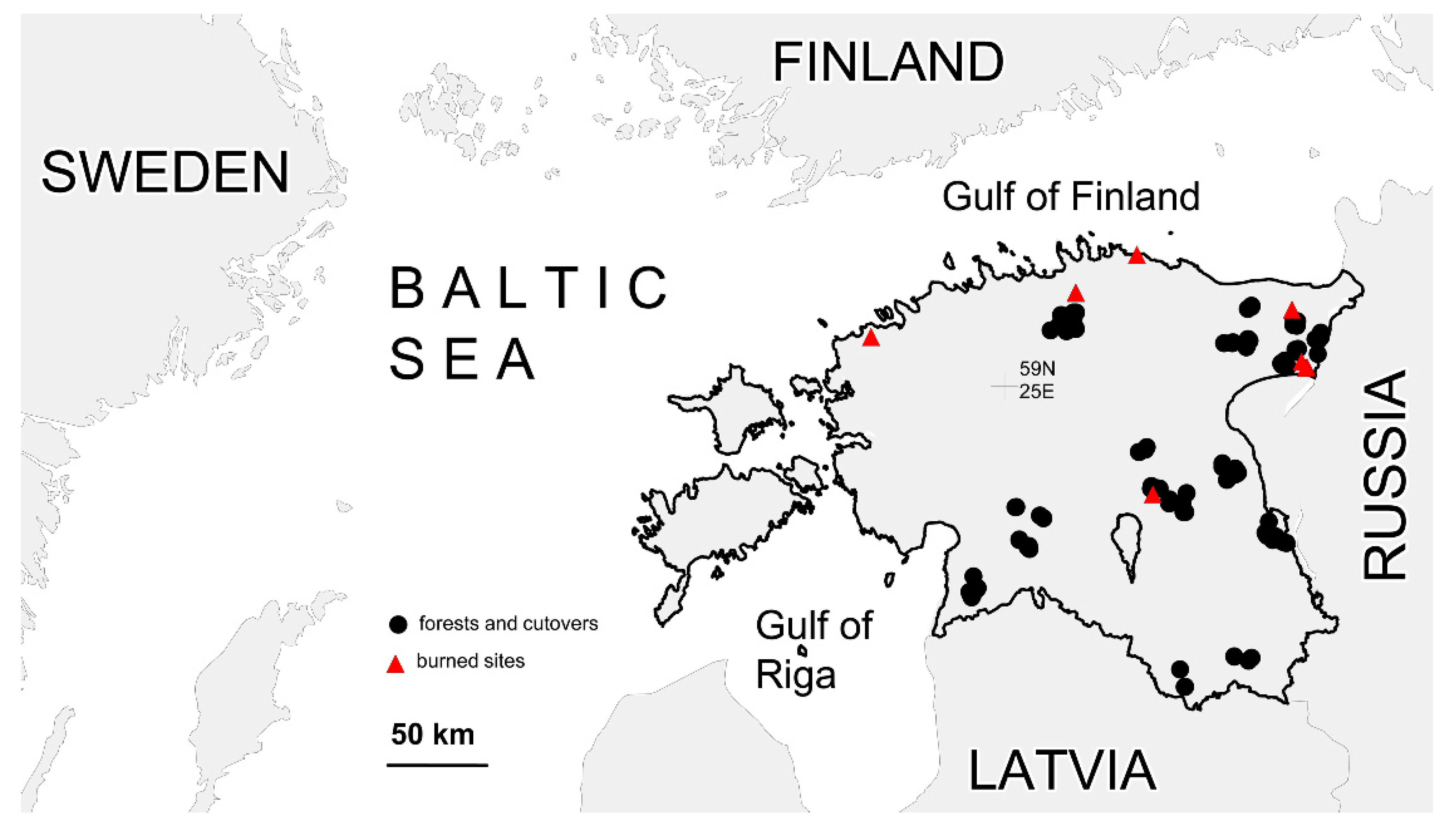
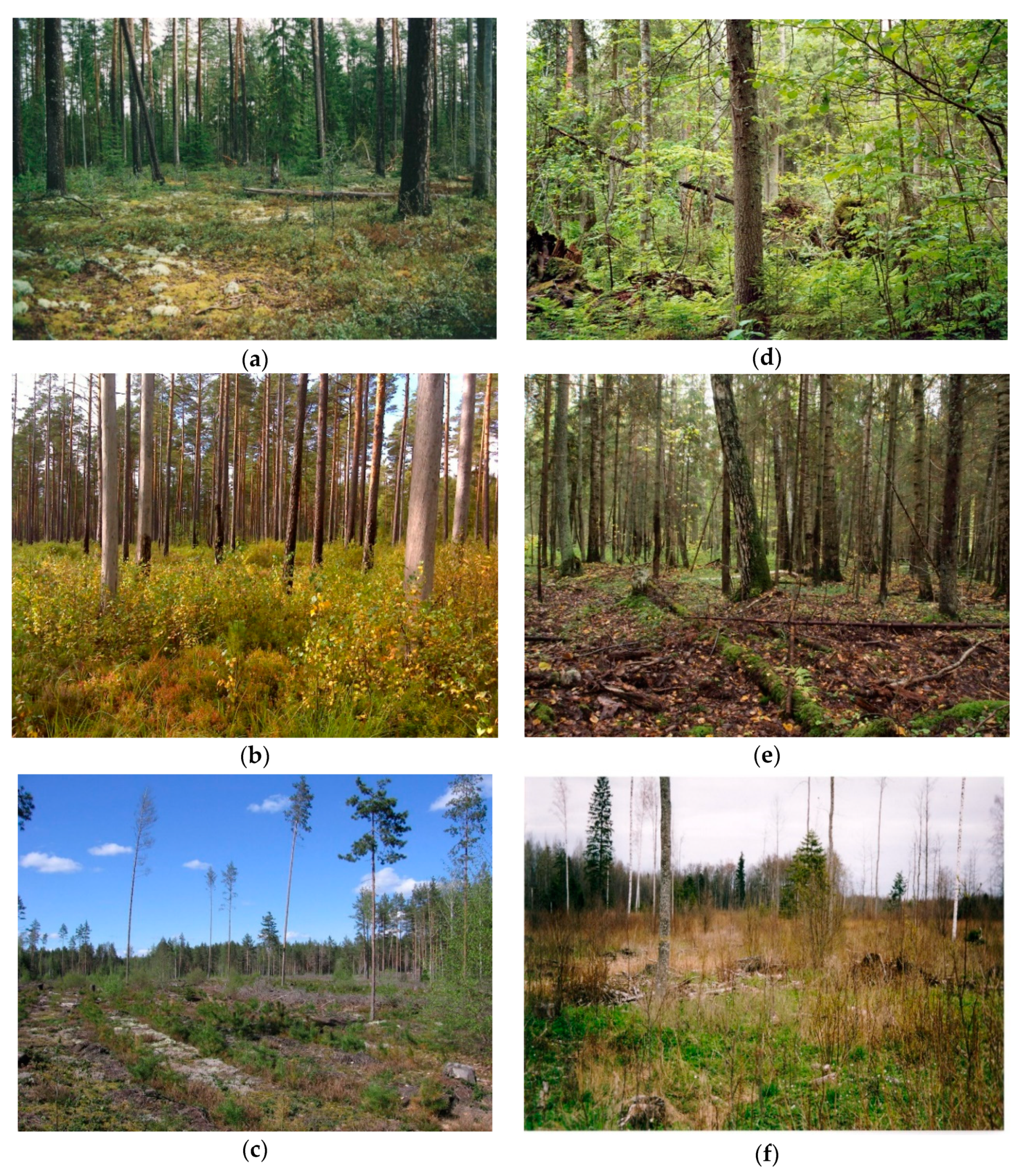
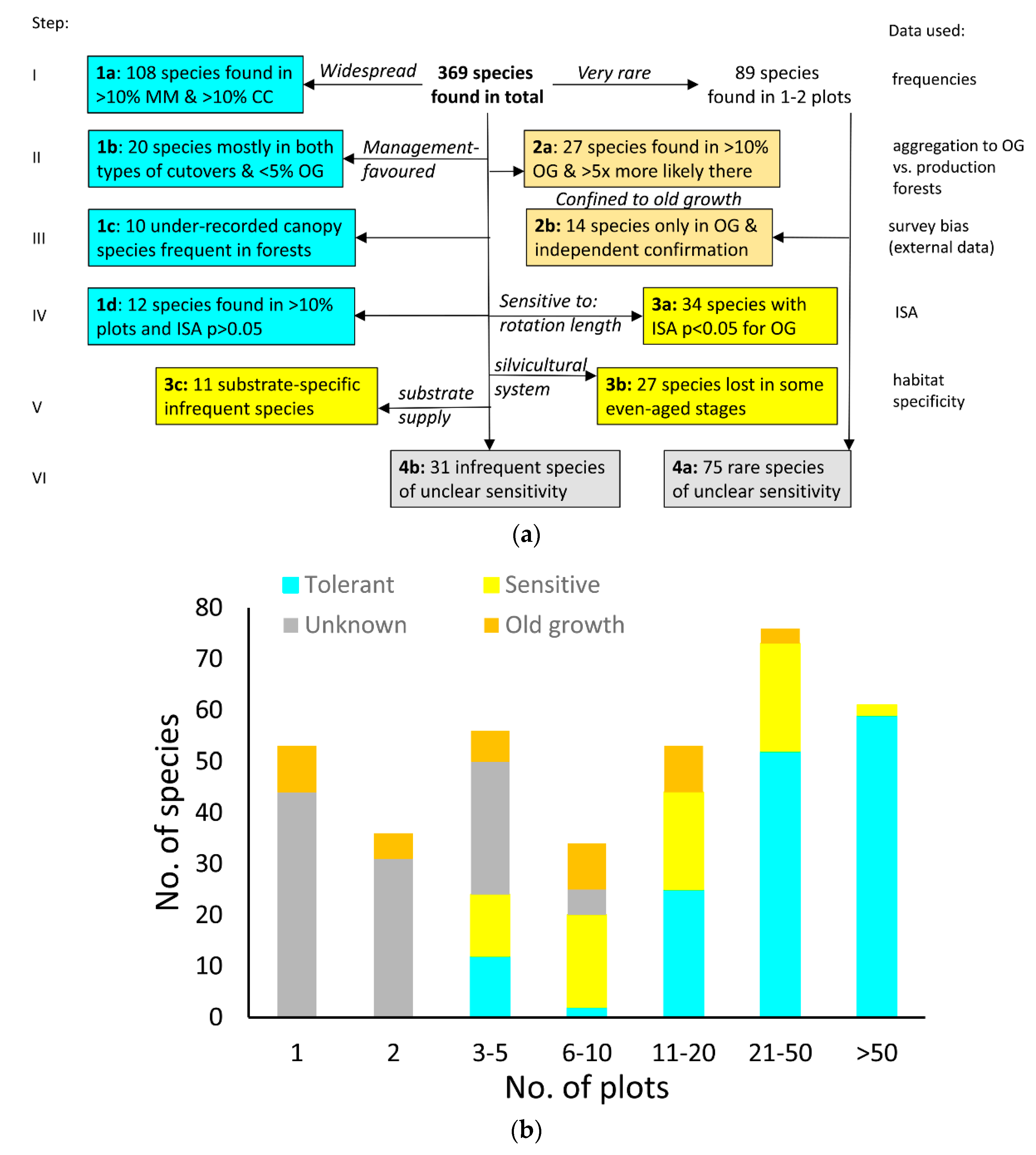
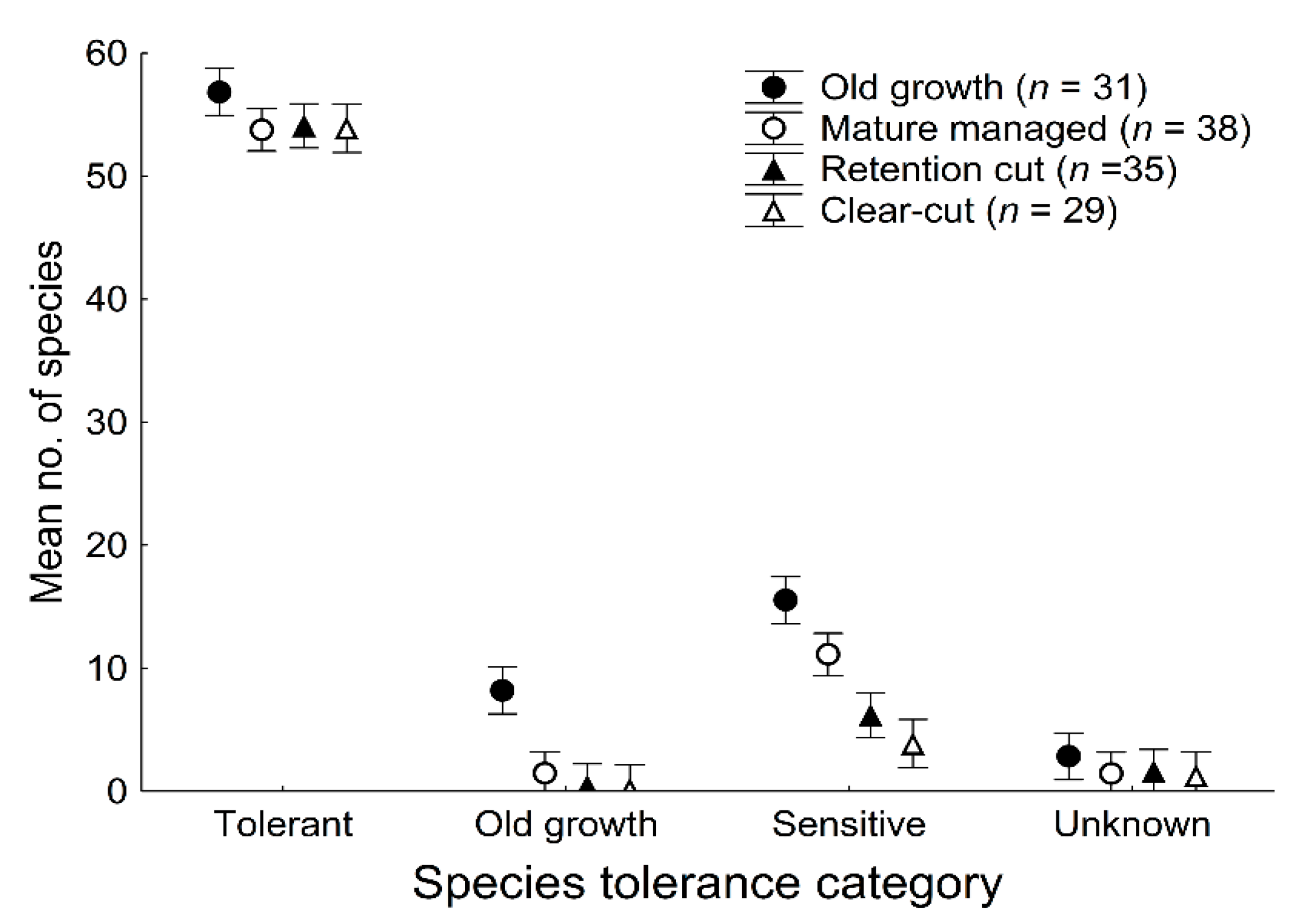
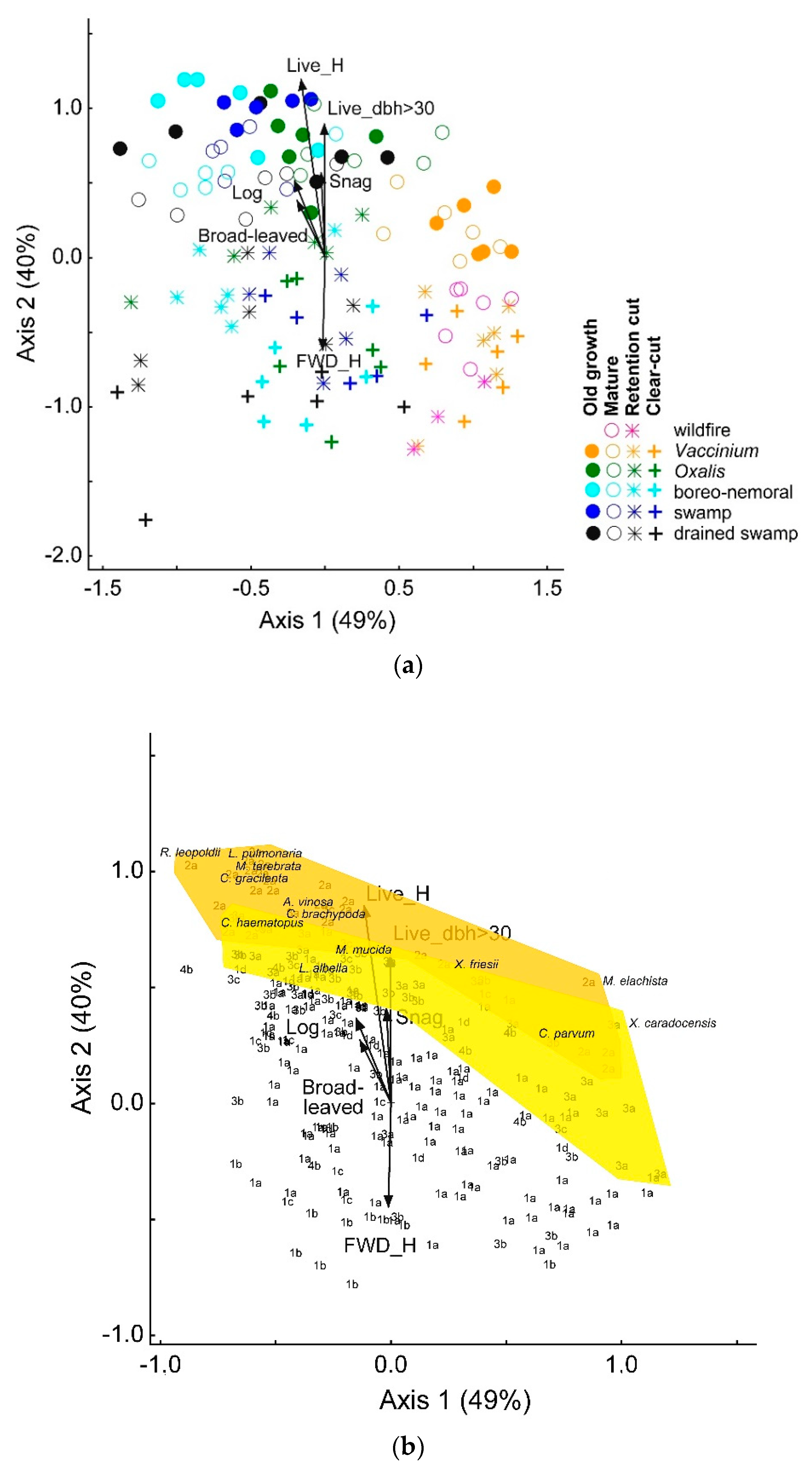
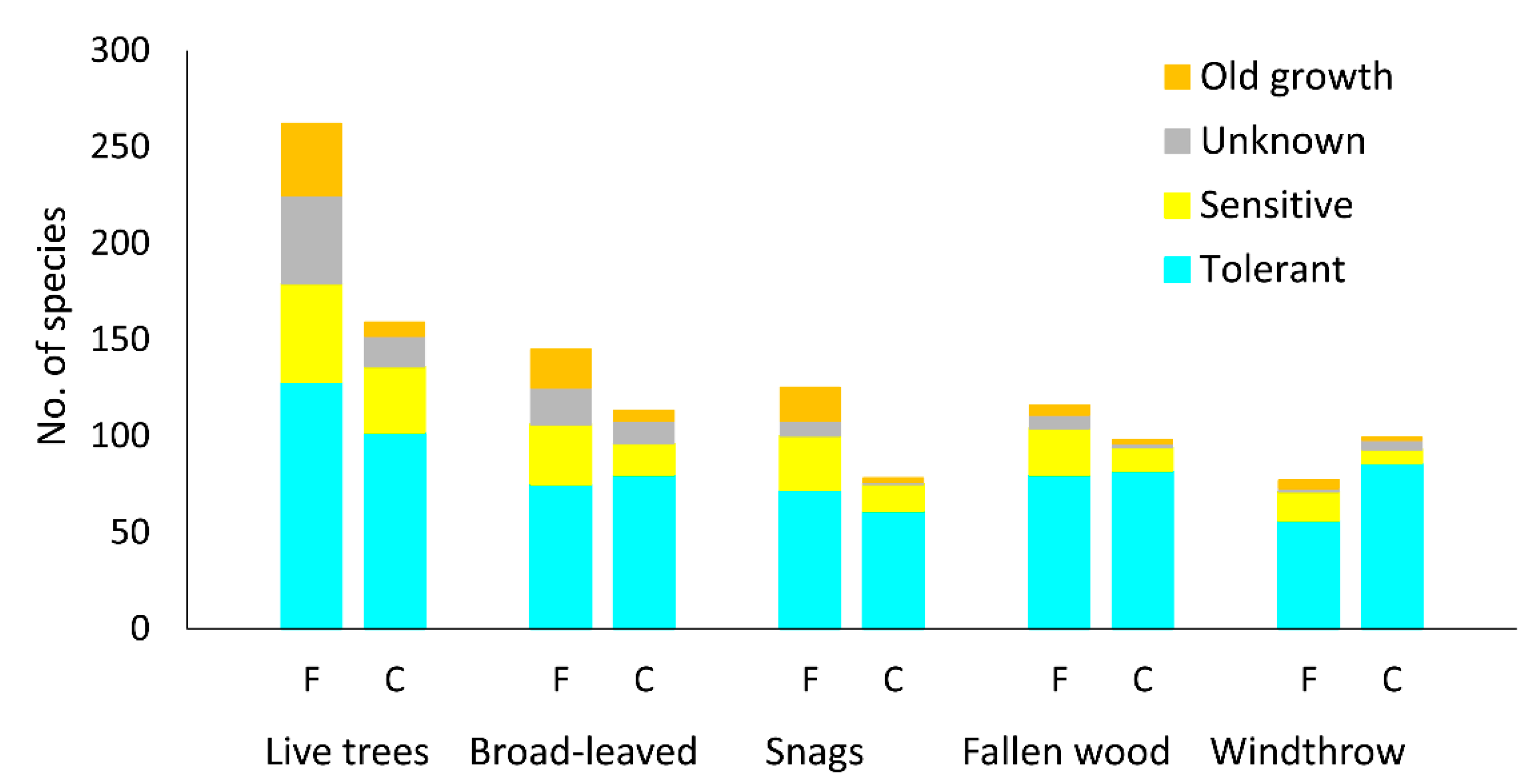
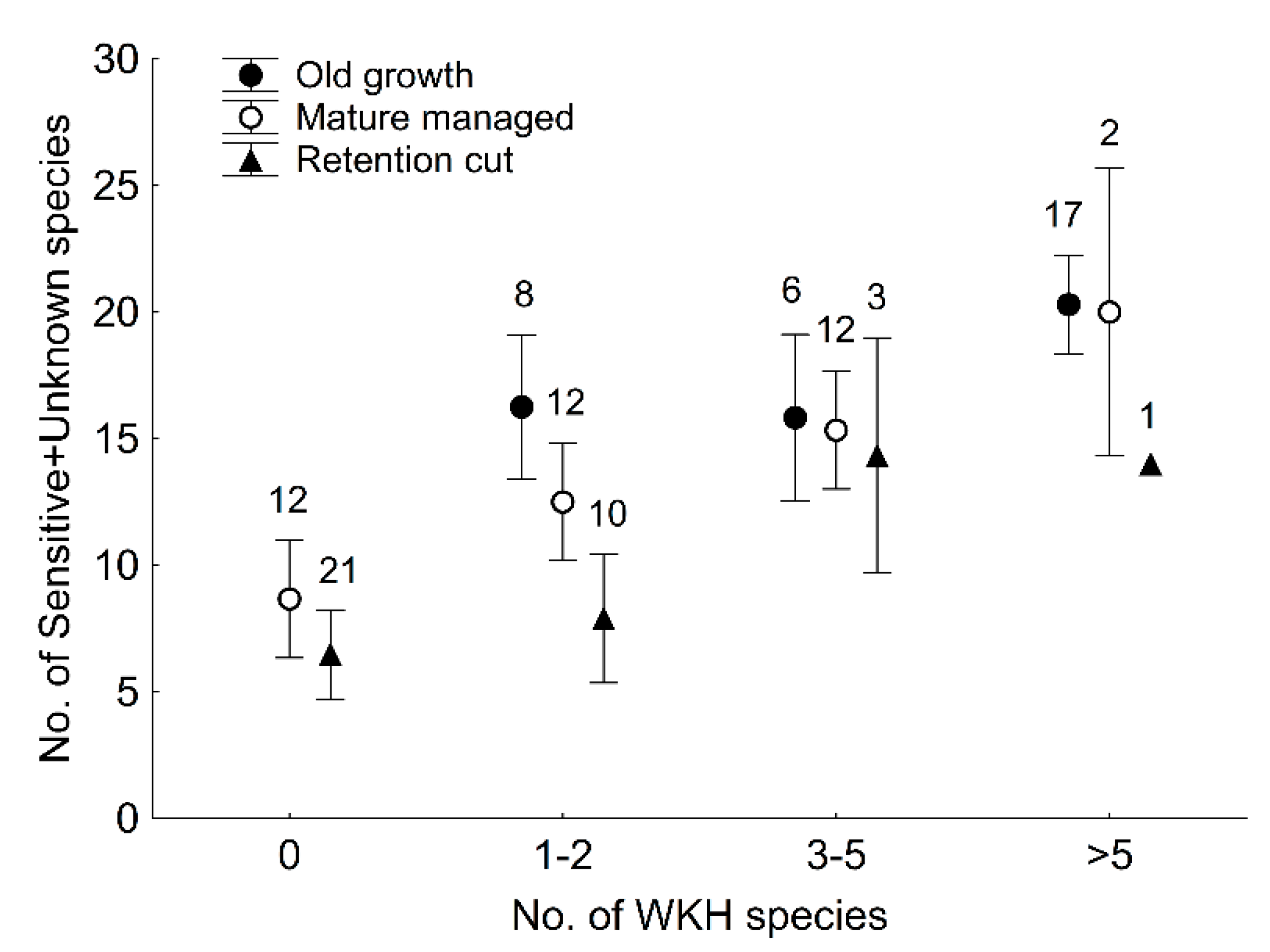
| Tolerance | No. of Species | |||||||||
|---|---|---|---|---|---|---|---|---|---|---|
| Thallus Type | Photobiont | Dispersal Mode | Lichen Substance | |||||||
| Macro- Lichens | Micro- Lichens | Trebouxio- Phyceae | Ulvo- Phyceae | Cyano- Bacterium | Not Lichenized | Vegetative Only | Sexual or Mixed | Yes | No | |
| Tolerant | 59 | 91 | 130 | 7 | 5 | 8 | 19 | 131 | 104 | 46 |
| Old growth | 10 | 31 | 22 | 10 | 5 | 4 | 4 | 37 | 21 | 20 |
| Sensitive | 14 | 58 | 54 | 6 | 2 | 10 | 8 | 64 | 43 | 29 |
| -retention | 10 | 40 | 39 | 6 | 2 | 3 | 7 | 43 | 31 | 19 |
| -snag | 0 | 10 | 6 | 0 | 0 | 4 | 1 | 9 | 6 | 4 |
| -ground | 4 | 8 | 9 | 0 | 0 | 3 | 0 | 12 | 6 | 6 |
| Unknown | 27 | 79 | 70 | 7 | 4 | 25 | 16 | 90 | 43 | 63 |
| Total | 110 | 259 | 276 | 30 | 16 | 47 | 47 | 322 | 211 | 158 |
| Species (Ecological Group) | Limiting Process | Proposed Target | References |
|---|---|---|---|
| Old-Growth dependent species in protected forests | |||
| Lobaria pulmonaria (epiphytic macrolichen) | Dispersal/establishment | Spatio-temporal connectivity of nemoral broad-leaved trees and aspen in reserves | [42,77,96,105,106,107,108] |
| Menegazzia terebrata (epiphytic macrolichen) | Air moisture and quality | Hydrologically intact semi-open moist and wet forests | [16,105,109,110] |
| Chaenotheca gracilenta (epixylic microlichen) | Microhabitat | Supply of shady moist microhabitats on dying and uprooted old trees in reserves | [15,43,50,105] |
| Xylopsora friesii (epiphytic/epixylic microlichen) | Disturbance regime | Conifer forests with continuity of small-scale disturbances and slow-grown old trees | [46,111] |
| Species sensitive to reduced rotations and functioning of mature production stands | |||
| Arthonia vinosa (epiphytic microlichen) | Microhabitat and –climate | Mature species-rich moist and wet forests | [16,42,46,81,105] |
| Chaenotheca brachypoda (epiphytic/epixylic microlichen) | Microhabitat | Supply of senescent trees with bark and wood crevices in close-canopy stands | [15,43,50,105] |
| Chaenothecopsis haematopus (saproxylic calicioid fungus) | Fungal tree pathogens | Soft exposed wood on deciduous trees that die standing | [15,43,112] |
| Calicium parvum (epiphytic microlichen) | Pine management | Landscape-scale continuity of mature pine stands | [15,88,105] |
| Multiclavula mucida (epixylic basidiolichen) | Full decay cycles of fallen trees | Supply of well decayed large trunks in close-canopy stands | [105] |
| Species dependent on retention forestry | |||
| Lecanora albella (epiphytic microlichen) | Late-successional tree species | Supply of mid-aged or old nemoral broad-leaved trees in close-canopy stands | [59] |
| Leptogium saturninum (epiphytic macrolichen) | Stable pool of mature aspens | Stand-scale continuity of mature aspen trees hosting the lichen | [105,113] |
© 2019 by the authors. Licensee MDPI, Basel, Switzerland. This article is an open access article distributed under the terms and conditions of the Creative Commons Attribution (CC BY) license (http://creativecommons.org/licenses/by/4.0/).
Share and Cite
Lõhmus, P.; Lõhmus, A. The Potential of Production Forests for Sustaining Lichen Diversity: A Perspective on Sustainable Forest Management. Forests 2019, 10, 1063. https://doi.org/10.3390/f10121063
Lõhmus P, Lõhmus A. The Potential of Production Forests for Sustaining Lichen Diversity: A Perspective on Sustainable Forest Management. Forests. 2019; 10(12):1063. https://doi.org/10.3390/f10121063
Chicago/Turabian StyleLõhmus, Piret, and Asko Lõhmus. 2019. "The Potential of Production Forests for Sustaining Lichen Diversity: A Perspective on Sustainable Forest Management" Forests 10, no. 12: 1063. https://doi.org/10.3390/f10121063
APA StyleLõhmus, P., & Lõhmus, A. (2019). The Potential of Production Forests for Sustaining Lichen Diversity: A Perspective on Sustainable Forest Management. Forests, 10(12), 1063. https://doi.org/10.3390/f10121063





